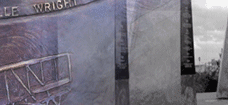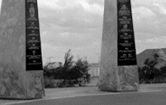Site
Preparation
Construction gets underway as
footings for the Monument's fourteen pylons are laid. Concrete is transported
in buckets by crane to the top of the high dune. Glenn Eure, grabs a shovel and
gets in the act (center). The inside concrete foundation for the brick
courtyard and platform for a center bronze dome are poured.
Fabrication
While site work is underway in Kitty
Hawk, the Monument's fourteen pylons are fabricated by the Jubrans at their
Grimesland, NC studio. A crane is used for lifting and moving the pylon
structures, which range in height from 10 feet to 20 feet and weigh from 600 to
over 1,000 pounds each.
Hanna Jubran demonstrates the
sanding pattern that will be used on the stainless steel pylons as Donald W.
Bryan, then Icarus Treasurer and in 2004 President of Icarus, looks on. At
Grimesland, Jodi Hollnagel Jubran creates the clay sculpture from which the
Jubrans cast the bronze center dome for the Monument.
In the workshop of Parker Monuments
in Knightdale, NC, Frank Parker prepares 2 x 6 foot black granite panels which
will be installed on the faces of the pylons and inscribes language chronicling
one hundred of the most significant events in aviation in its first century.
Charles Pulley assists him. In late August in Elberton, Georgia, images drawn
by Glenn Eure are transferred to etchings on the inscribed panels. Here Eure
paints the red tail and spinner for the Tuskegee Airmen logo on the panel for
the sixth pylon.
Pylon
Installation
With the Monument site in Kitty Hawk
now ready for installation of components, the finished pylons arrive at the
site around sunset on September 12. The next morning the flatbed and crane move
into position. It is an exciting moment when the first pylon is lifted, with
Hanna Jubran assisting, from the truck and soars across the blue sky on its own
flight to become part of the Moument to a Century of Flight. Glenn Eure awaits
its arrival at the destination.
One by one the pylons
travel up the hill and are lowered in a special harness to be fastened on rods
put in place when the footings were laid and then welded.
Another reality interrupts the work
on September 16 as Hurricane Isabel approaches the North Carolina coast and
Wimco's Bruce Hendrix "boards up" the pylons that do not yet have the black
granite in place. Icarus Co-Founder Denver Lindley assists.
Brick
Installation
Work moves ahead as bricks and gray
granite paving stones engraved by Parker Monuments and delivered to the site
prior to the hurricane are installed in the courtyard. Larry Ray (shown center
with Parker's Brian Ferraraccio on the left), from Parker Monuments is in
charge of this phase of Monument work. Together with brick installer Arthur
Haskell (right), a brick pattern is designed to adapt to the courtyard's oval
shape and provide maximum strength. The initial installation includes over
3,000 bricks that have been inscribed with sponsors' names or
messages.
Final
Details
The Monument nears completion with
placement of a black granite entrance marker. One side of the marker, prepared
by Clifton & Clifton of Elizabeth City, NC, is engraved with the poem "High
Flight" written by a 19-year old fighter pilot, James Magee, shortly before his
death in 1941.
Near the entrance marker to the
Monument, Wimco's Bruce Hendrix and Monument artist Glenn Eure install the
vault for a Time Capsule to be opened in the next century by the people of
2103.
N.C. Department of Transportation's
Landscape Architect, Pat Mansfield (not shown), oversaw the installation of
watering systems and plants to beautify the natural setting and further
stabilize the dune – including yaupon holly, wax myrtle, loblolly pine and
live oak and daylilies.
|


